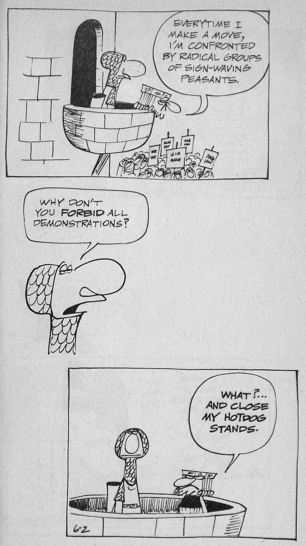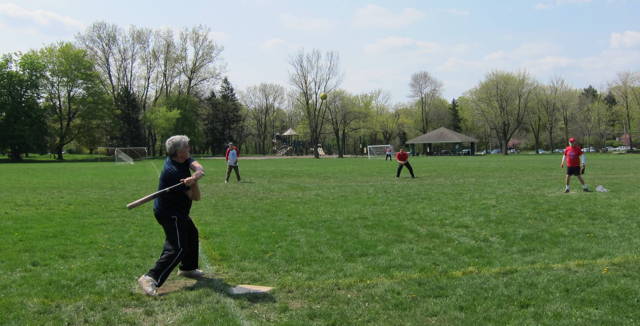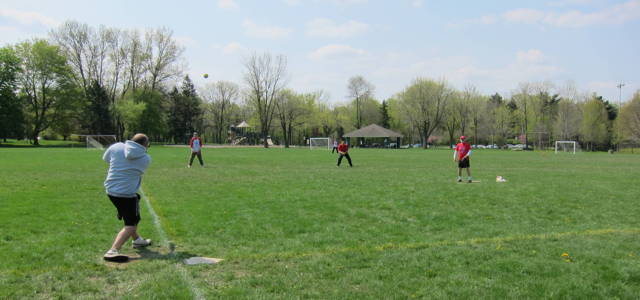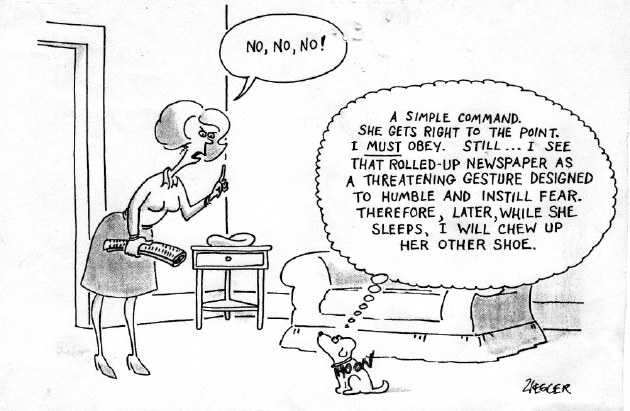
Monthly Archives: May 2011
Free Play Puddle League
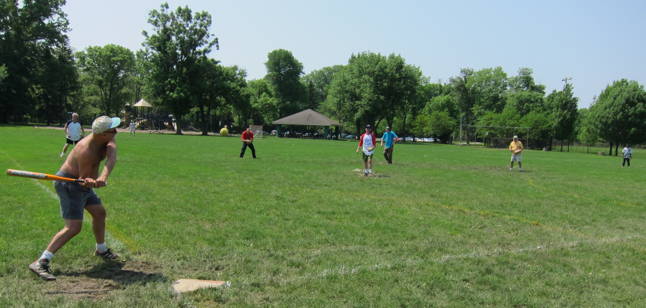
Pete “the body” lines up the pill. Pete, incidentally, is a lock for comeback player of this Free Play season, seeing as he’s recently acquired two bionic hips. Sunday was likely the latest we’ve ever enjoyed our first full complement of players. ighteen eventually rolled in and the contest ended up a roller coaster ride. We’re quite resourceful, and have been especially so in a season in which we’ve played four times with anywhere from ten to last week’s eighteen players, amidst four rain outs. Although players get to bat a bunch in five-on-five games, the sixth players adds the first baseman, and, the seventh adds a right fielder. So far one constant is the soggy field peppered with puddles.
Filed under experiential learning
Teaching Cartoon – Context
Hart and Parker have long been among my go-to cartoonists for looking for examples that echo the ‘trickster’ wisdom traditions. The Wizard of Id has long been equal to Peanuts in my estimation on this account.
Filed under experiential learning, humor
Never Two Be Seen – Two Coyote Stories
I.
Coyote’s wife dies of an illness and he weeps for her. He is visited by the death spirit who offers to take him to the land of the dead if Coyote will follow his instructions. Coyote agrees. On their journey the spirit points out a herd of horses. Coyote cannot see the horses but he pretends that they are there. Neither can Coyote see the death spirit. He appears to be a shadow. When Coyote and the death spirit arrive at the land of the dead the spirit invites Coyote to eat some berries. Coyote cannot see them but pretends to eat them nevertheless.
The spirit leads Coyote to a lodge and tells him to enter through the doorway and sit down beside his wife and eat the food that she has prepared for him. Coyote cannot see the lodge, the food, or his wife, but he obeys the spirit. When night falls Coyote sees the lodge that he could not see during the day, and in it are fires, and people he knew when they were living and, of course, his wife. With the dawn, everything and everyone disappears, only to return on the following evening. It is like this for several days and nights.
Eventually the death spirit tells Coyote that he must leave. The spirit allows Coyote to take his wife with him but warns that he must not touch her until they have crossed the fifth mountain of the five mountains that lie between the lands of the living and the dead. Coyote agrees. Coyote and his wife begin their journey. At night they sit with a fire between them and Coyote notices that with every night his wife’s form becomes clearer. On the last night of the journey Coyote can wait no longer and reaches across the fire to embrace his wife. She disappears the moment he touches her.
The death spirit returns and tells Coyote that because of his foolishness the practice of returning from the dead will never be and that the dead must remain forever separate from the living. The spirit leaves. Coyote tries to return to the land of the dead, repeating everything he was instructed to do on the first journey: he pretends to see a herd of horses, to eat berries, to enter a lodge, to acknowledge his wife, and to eat the food she has prepared for him. When evening comes the lodge, the fires, the people, and Coyote’s wife do not appear, and they and the death spirit never appear to Coyote again.
II.
Two Coyotes were going upriver and came to a big bench. From there they saw people living below, near the river. Then the two friends said to each other, “you go ahead.” Then one says “No. You go,” and the other said “No.” And they argued and protested for a long time. Then one said, “You go first they will see you any moment and say `there is a coyote.’” They were going on the trail. [The other said] “I am not a coyote.” [The first said,] “But you are just the way I am. We are the same in every way. We are both coyotes.” [The other said,] “No, I am just `another one.’” In this way they argued.
Then the second one said to the first, “You go first.” There was a ridge on which people could see everything from below. When he [the first] started walking, went on, and went over a small ridge, the people below said, “There is a coyote going upstream.” Then they [people] came out and watched the coyote going. “See?” he said. “See what they said? You are a coyote.” “Come! You too.” he said. “They will say the same of you. You are a coyote.” “All right. I will go” [said the other], and he also slowly started walking on the trail from there. Then [people said], “Ah, another one again. There is another one.” Then he came to the first, saying, “See? I am not a coyote. I am `another one.’ See, the people said that I am `another one.’” That’s all.
source: paraphrase by :Larry Ellis, Trickster: Shaman of the Liminal, SAIL Studies in American Indian Literatures; Series 2; Volume 5, Number 4; Winter 1993
(republished from Transformative Tools blog)
Filed under adult learning
A Manny We Can Believe In
This post is going to be a: figure it out on your own terms kind-of-post.
Cleveland Indians – The Glory Years, and, 2007
1994 2nd 66 47 .584
1995 1st 100 44 .694
1996 1st 99 62 .615
1997 1st 86 75 .534
1998 1st 89 73 .549
1999 1st 97 65 .599
2000 2nd 90 72 .556
2001 1st 91 71 .562
(5 seasons out of it)
2007 1st 96 66 .593
(3 seasons out of it)
2007 Cleveland Indians – starters
C Victor Martinez
1B Ryan Garko
2B Josh Barfield
SS Jhonny Peralta
3B Casey Blake
LF Jason Michaels
CF Grady Sizemore
8 Franklin Gutierrez
DH Travis Hafner
also on team
Shin-Soo Choo
Astrubal Cabrera
pitching staff-2007
Fausto Carmona
Cliff Lee
Jason Stanford
CC Sabathia
Jake Westbrook
Paul Byrd
Jeremy Sowers
Rafael Betancourt
Joe Borowski
Aaron Fultz
Aaron Laffey
Edward Mujica
Matt Miller
Rafael Perez
Mike Koplove
Jason Davis
Juan Lara
Fernando Cabrera
Tom Mastny
Roberto Hernandez
Jensen Lewis
Sox See What May have Been (Boston herald, Tuesday, May 24)
CLEVELAND — When last night’s game finally got started, it was hard not to notice who was there.
And who wasn’t.
Justin Masterson was highly visible, throwing the first pitch for the Indians to his former teammates.
Victor Martinez, the player responsible for Masterson’s presence, was 169 miles away serving as the Detroit Tigers designated hitter.
The story of how Masterson became a reliable, effective starter for the major leagues’ best and most surprising team began July 31, 2009. That’s when he was traded by the Sox, along with left-hander Nick Hagadone (who recently was promoted to Triple A after posting excellent relief numbers in Double A) and right-hander Bryan Price, to the Indians for Martinez, who still had an affordable 2010 option on his deal before becoming eligible for free agency.
The Red Sox [team stats] never were willing to ink Martinez to the four-year deal he wanted, opting to use some of the dollars they saved on him and Adrian Beltre for even bigger contracts for Carl Crawford and Adrian Gonzalez. Considering the Sox also will have the 19th pick in the first round of next month’s draft, and a supplemental pick, as compensation from the Tigers, it’s not fair to say they got nothing out of the Martinez deal. Don’t forget, Martinez hit .313 with a .865 OPS, 28 home runs and 120 RBI in 183 games with the Sox.
Still, last night the Sox came face to face with Masterson, who is 5-2 with a 2.50 ERA after tossing 72?3 strong innings in the Tribe’s 3-2 win. Martinez, with his .303 average, four homers and 25 RBI, was nowhere to be found.
“At this juncture in time, it looks as if the trade accomplished what we wanted to accomplish, but examining a trade at any static moment is difficult to really do,” said Mark Shapiro, currently the president of the Indians who dealt with Sox general manager Theo Epstein in the Martinez deal. “In the end, one thing we accomplished with that trade is that you want trades to be a win-win because you want them to be a platform for the next trade. So, Victor did exactly what we told Theo he would do. And, Masterson is developing into the pitcher that we hoped he could develop into. There was some uncertainty there. And Hagadone looks to be the guy we thought he would be.”
If the Masterson-Martinez trade stood out like a sore thumb to Sox followers last night, imagine how the game must have appeared to Seattle fans. The Mariners likely do not feel as if they are in a win-win situation after dealing with the Indians, who sent Ben Broussard and cash to Seattle for outfielder Shin-Soo Choo in one deal and Eduardo Perez for shortstop Asdrubal Cabrera in another in the span of a month in the summer of 2006.
The small-market Indians and Shapiro have had to make other deals, of course: Bartolo Colon had to go, which brought in Grady Sizemore, Cliff Lee and Brandon Phillips. CC Sabathia was dealt for first baseman Matt LaPorta and center fielder Michael Brantley, Casey Blake for catcher Carlos Santana and Mark DeRosa for closer Chris Perez.
11-2 against Seattle and Kansas City, the Tribe is 19-13 against everybody else so far.
Baseball is my first sportsbo passion, ever since I was a kid. I could go into this but suffice to say it has a pace like that of my personality, and, similarly, weird and wonderful stuff happens in baseball on a regular basis.
By opening day, I had put in the hour of talent analysis, and, figuring Sizemore and Hafner were unlikely to have a career year ever again, and figuring the bullpen was mostly an X factor, and writing Fausto Carmona down for no more than ten wins, and, ignoring spring training, I came up with an “informed” estimate of the team’s potential: 65-75 wins.
I’m not sticking to this estimate anymore; 80-90 wins.
It’s been amusing to hear the homers call into the post game radio sports shows to highlight the spooky accuracy of their pre-season prognostications.
I told my freeplay pal and baseball elder Tom that there was one factor above all the rest I was most blown away with, in the revitalization of the Cleveland Indians. Manny Acta. He agreed. I highly recommend fans visit his Wikipedia page for the background.
Baseball, globally speaking, seems to be trending to 1968, with the advantage tipped toward the throwers. This is dandy as far as I am concerned. This also meshes with the Tribe’s main strength, pitching on both the major league roster and throughout the minor league system.
The Indians are really fun to watch. More fun than the 2007 team that scored a lot of runs, almost got back to the world series, and featured musical chairs in the bullpen. They are embarking on a very challenging part of the schedule without Sizemore and Haffner, so, even with another win against the Bosox in the pockets, the next three weeks will really show us what this team is made of.
Filed under Cleveland
Misinformation and the Other Kind of Information
(Following from\Swinging on the Hammock) Okay, watch the video. I’ve highlighted the moment that jumps out for me.
RYAN: It’s a sign of the times, I think. I think it’s a sign of anxiety of the times. It’s also a sign of the misinformation that’s been perpetrated out there.
AMANPOUR (on-screen): Well, why do you say “misinformation”?
RYAN: Well, there are TV, radio and phone calls that are running, trying to scare seniors. You know, the Democratic National Committee is running phone calls to seniors in my district, TV ads, saying we’re hurting current seniors when, in fact, that’s not the case. And so there’s a lot of…
AMANPOUR: Isn’t that, though, par for the course?
(CROSSTALK)
AMANPOUR: I mean, didn’t you lot do it the last time?
RYAN: Yes, Republicans — Republicans — both parties do this to each other. And my whole point about that is, that’s why we have this political paralysis.
Let’s entertain a thought problem. Scroll ahead to a perfect Tea Party storm in the 2012 election, after which the Ryan health care overhaul becomes a reality. Shortly afterward we’d know for sure which seniors are getting hurt. I assuming the meaning of ‘hurt’ is that the cost of health care for those over 65 undergoes a non-trivial increase. In anticipation of this, since all we have is the letter of the current plan, whether it hurts current seniors–say, those born before 1947–is answerable in the exacting terms articulated in this current plan.
Without parsing the exact position on this found in the plan, it’s interesting to suppose this perfect electoral storm happens, and, shortly afterward, passing and implementation of, for the sake of argument, Ryan’s current plan. Obviously, a year later we would have the painless ‘old system’ co-existing with a few or all elements of the privatization scheme, for those too young to be grandfathered into ‘regular Medicare.’ How this would work is an unspecified group of adults shy of 65 right now would be allowed to enroll in Medicare when he or she reaches 65. The most talked-about cutoff for current adults is 55. What I will term, Medicare II, the voucher-driven and privatized Ryan plan, kicks in 2022.
Of course we know that ‘hurt’ as previously defined is the truth about the privatized scheme. It would seem politically untenable to have a dual system play out over forty to fifty years–until all the ‘Medicare’ seniors die off. However, the point of my thought problem is this: the assertion that Medicare seniors would not be subjected to ‘hurt’ is entirely contingent on there being zero changes to the current Medicare provision. So, to falsify the assertion all one has to do is go into the Ryan plan and see if it is, in effect, a zero change (to Medicare) plan for this select group of seniors.
There really isn’t a Ryan Plan. Take a look yourself, it’s a wish list. I suspect what would happen is that Medicare I. would be substantially altered to bring it down toward the benefits and objectives (“socialize risk/privatize profits”) of Ryan’s actual concrete, Medicare II. plan. He’s got a rhetorical agenda: to convince adults over the age of 55 (in 2011 or 2012) that they will enjoy the level of coverage, low premiums, and unpredictable pharmaceutical co-pays (Medicare D,) of Medicare I. while moving to abolish it for everybody else– Medicare II. I’m suggesting there is zero chance implementation of a actual Ryan Plan would leave Medicare I. unscathed for the 55-and-older crowd. It’s the other shoe–to be dropped.
From page 46, The Path to Prosperity, Fiscal Year 2012 Budget Resolution, (where the Ryan, health care plan is sketched out.)
These reforms also ensure affordability by fixing the currently broken subsidy system and letting market competition work as a real check on widespread waste and skyrocketing health-care costs. Putting patients in charge of how their health care dollars are spent will force providers to compete against each other on price and quality.
That’s how markets work: The customer is the ultimate guarantor of value.
Market competition hasn’t delivered any check on waste and costs in the segment of the market that is totally privatized, non-Medicaid and non-Medicare insurance. One reason is: markets do not work the way Ryan states that they do.
Ryan here makes a criticism about a gang of thirteen deciding health care benefits. However, his own proposal replicates what we have now, which is an army of thousands of ‘deciders’, and each serves masters whose proprietary objective is to make money.
Filed under current events
Freeplay Emerges after the Big Submerge
After two rain outs, Freeplay Softball recommenced on a makeshift diamond caddycorner from ol’ Field No.8, on a cool but sparkling day. We are resourceful: we started with ten which forces us to play with two outfielders, two infielders, and the innovative ‘pitcher’s mound,’ where infield hits go to die.
By the third inning, two players had rolled in, and we had our first basemen. After arriving at six on each side the game was back and forth for two innings but then became a rout. I’m the handicapper, so the sudden disparity in performance can look like it falls on me. But, heck, I can’t hit and catch and throw for anybody but myself. The opposing team should have challenged the left fielder a bit more! (One fly to left and its crusty, slow denizen…)
Freeplay Softball, an experiment in self-organization, magnanimity, and experiential learning, continues its 20th season Sundays, 9:30am. Open to all over the age of 13, Forest Hills, Cleveland Heights.
Filed under experiential learning
Commit it then to the flames

David Hume, 300th birthday today.
We may observe in human nature a principle which, if strictly examined, will be found to diminish extremely the assurance, which we might, from human testimony, have, in any kind of prodigy. The maxim, by which we commonly conduct ourselves in our reasonings, is, that the objects, of which we have no experience, resemble those, of which we have; that what we have found to be most usual is always most probable; and that where there is an opposition of arguments, we ought to give the preference to such as are founded on the greatest number of past observations. But though, in proceeding by this rule, we readily reject any fact which is unusual and incredible in an ordinary degree; yet in advancing farther, the mind observes not always the same rule; but when anything is affirmed utterly absurd and miraculous, it rather the more readily admits of such a fact, upon account of that very circumstance, which ought to destroy all its authority. The passion of surprise and wonder, arising from miracles, being an agreeable emotion, gives a sensible tendency towards the belief of those events, from which it is derived. And this goes so far, that even those who cannot enjoy this pleasure immediately, nor can believe those miraculous events, of which they are informed, yet love to partake of the satisfaction at second-hand or by rebound, and place a pride and delight in exciting the admiration of others. (An Enquiry Concerning Human Understanding)
As a (William) Jamesian, Hume was the precedent. Called the greatest philosopher “who wrote in English,” to me, he was the foremost “proto modern philosopher,” and the philosopher, besides, James, I’ve spent the most time with. From my perspective, skepticism as empirical approach, is what allows for one to see the many, albeit partial, sides of a problem, viewpoint, ideology. Also, as approach and attitude, it’s related to systems awareness in our modern sense, thus, for example, this moves us to regard all the factors of influence and inflection, especially the human subjective factors, in any description, explanation, prediction, or idealization of a system, or systems of systems.
But setting aside some metaphysicians of this kind, I may venture to affirm of the rest of mankind, that they are nothing but a bundle or collection of different perceptions, which succeed each other with an inconceivable rapidity, and are in a perpetual flux and movement. Our eyes cannot turn in their sockets without varying our perceptions. Our thought is still more variable than our sight; and all our other senses and faculties contribute to this change: nor is there any single power of the soul, which remains unalterably the same, perhaps for one moment. The mind is a kind of theatre, where several perceptions successively make their appearance; pass, repass, glide away, and mingle in an infinite variety of postures and situations. There is properly no simplicity in it at one time, nor identity in different, whatever natural propension we may have to imagine that simplicity and identity. The comparison of the theatre must not mislead us. They are the successive perceptions only, that constitute the mind; nor have we the most distant notion of the place where these scenes are represented, or of the materials of which it is composed. (A Treatise On Human Nature)
Robert Bell David Hume’s Fables of Identity
David Hume’s Birthday at Crooked Timber
David Hume’s Birthday at Cognition and Culture
article by Yumiko Inukai, University of Pennsylvania The historical Buddha (Gotama), Hume, and James on the self: Comparisons and evaluations
We are inclined to believe that we are persisting, unified subjects that undergo experience, whether or not we believe in souls or substantial entities of some sort that are often posited as persisting subjects. Where does this belief come from? To deal with this question, I examine David Hume’s and William James’ accounts of the self, both of whom attempt to provide the empirical basis for such a belief. In the Appendix to A Treatise of Human Nature , Hume acknowledges that his account of our belief in a persisting self offered earlier in that work involves a profound problem that he has no hope to solve. Contrary to the common interpretation that puts Hume’s newly-found problem in his very account of the idea of the self, I suggest that it arises from his presupposition throughout Book One of the Treatise that perceptions are initially bundled together. I argue that Hume’s theoretical commitment to the radical independence of perceptions does not allow him to maintain the initial unity of perceptions (i.e., a unified self). Nor is he able to explain the formation of it. I call this the Bundling problem. In contrast, James improves upon Hume by developing more detailed descriptions of experience and simply avoids the Bundling problem by rejecting Hume’s atomistic theory of experience, affirming that experience is fundamentally unitary and continuous, which he calls “the stream of consciousness.” A rigorous analysis of experience enables James to account for our belief of a persisting subject on empirical grounds. Consideration of James’ accounts sheds a great light on Hume’s fundamental problem. I argue that Hume’s atomistic theory of experience–which proves to be the source of the Bundling problem–is a metaphysical theory, which is in conflict with his own professed empiricist methodology. The Bundling problem is not, therefore, inherent in his empiricism itself. Hence, there still is hope for an empiricist account of our belief in a persisting self, and this hope is found in James.
Filed under philosophy, William James
Viewing Time
A History of the World in 100 Seconds from Gareth Lloyd on Vimeo.
MY AFRICAN MIND from BOFADACARA on Vimeo.
Two completely different approaches to making a concise videographic presentation of the sweep of “a” history. Gareth Lloyd explains his methodology, and, there is a bit of background for the second video by Nastio Mosquito at Africa Is a Country.
Filed under sociology
The Hard Problem
Evolution Made Us All from Ben Hillman on Vimeo.
Actually, the proposition here over-generalizes, but it is apparently true for biological life.
I don’t track the follies of Intelligent Design anywhere near as closely as I used to, yet I do maintain a tag search and every now and then I am moved to go check out the ‘action,’ always with the hope what I encounter will be amusing, and, rich as a qualitative data set about how people approach talking with each other.
Uncommon Descent, ‘serving the intelligent design community,’ is a dependable source of circularity and a time waster over many years. I got a nice positive at the end of March. I’ve let it, the comment thread, percolate since then. It is: worthy.
The set-up is a article, On the Computation of CSI, by Mathgrrl. Here is the equivalent of its abstract.
In the abstract of Specification: The Pattern That Signifies Intelligence, William Demski asks “Can objects, even if nothing is known about how they arose, exhibit features that reliably signal the action of an intelligent cause?” Many ID proponents answer this question emphatically in the affirmative, claiming that Complex Specified Information is a metric that clearly indicates intelligent agency.
As someone with a strong interest in computational biology, evolutionary algorithms, and genetic programming, this strikes me as the most readily testable claim made by ID proponents. For some time I’ve been trying to learn enough about CSI to be able to measure it objectively and to determine whether or not known evolutionary mechanisms are capable of generating it. Unfortunately, what I’ve found is quite a bit of confusion about the details of CSI, even among its strongest advocates.
Setting aside the effort to configure a worthwhile computational platform for ID, the post and its continuing offshoot oneand offshoot two, interest me because Mathgrrl, (who is seemingly Lauren Taalman of James Madison univesity,) has made her effort without also grinding any axe. My further interest, then, is to see what happens as a matter of the responses to her generous and sincere effort. How soon will bad will arise by design (!) to meet her good will?
The answer, of course, is: instantly. 11:17am. However, overall the discussion proceeds without much aggression. (It’s not besides the point that Dembski’s CSI has been discredited, but, in another sense the dialogs are seeking to discover a corrective or more correct estimate.) Alas, it turns out a moderator is riding the posts too, so some of the action only saw the light of day briefly.
As a Batesonian, I was amused to read this (#367):
I am saying, per my previous post, and interminable posts prior to this on other threads, that is it impossible, IN PRINCIPLE, i.e. it is logically impossible, to explain information in terms of algorithms and/or physical laws. This so obviously true that it is scarcely worth repeating. So I won’t. You will sooner be able to create a square circle as to generate information with time and physics. Information is impossible without reason, language, free will, and intentionality. That is, a mind. Or Mind in the case of life.
Having now created the square circle, what say you? Why would information require logic to be represented in any possible explanation of information, and this given too in any possible ‘terms?’ Oh look, my square circle just rolled up my stairs!
In the main the discussants don’t reconcile Mathgrrl’s urge to define CSI with greater specificity with the ID company line, that Dembski’s conclusions have already completed the endeavor. All in all, not very amusing, except for the usual category mashing, and this–as always–in the context of the unspoken problematic implied by some kind of computationally clever designer found somewhere beyond nature and biology. And, maybe this designer was/is, like, undesigned?
Then: pay dirt. Mathgrrl Lives Down to Expectations on April 14. The post’s subject remains calm. She should get a medal. Between this and the action over at the unintentionally very amusing comment spew at intelligentreasoning blog, I am suddenly delivered to the social psychological nirvana I was hunting for.
Filed under science
Stars Raining
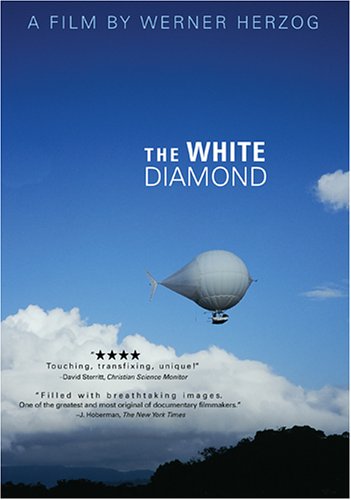
The White Diamond is my favorite Herzog movie at the moment. This is not to say it’s his best movie, and certainly I can rattle off a dozen moments from his opus I treasure, yet, this beautifully realized documentary about human aspiration under profoundly human circumstances is it, for me, right now.
Up date on my previous post; Mad German Auteur, Now in 3-D! is a somewhat untamed interview and recollection by Chris Heath at GQ.
WH “There is nothing glorious about making a film. It is an endless sequence of banalities.”
CH With a magical goal?
WH “Yes. But shooting a film itself is nothing but banalities. [Then, as though reluctantly, he continues.] However, there’s very rare moments where I get the feeling sometimes I’m like the little girl in the fairy tale who steps out into the night, in the stars, and she holds her apron open, and the stars are raining into her apron. Those moments I have seen and I have had. But they are very rare.”
Filed under cinema


